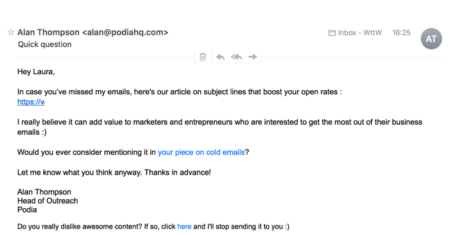When opens hurt reputation
- laura
- January 30, 2020
- Delivery improvement
Podia has scraped the Word to the Wise blog and I’m currently receiving an ongoing drip campaign from them absolutely begging me to mention them in my blog post on cold emails.
Related Posts
Marking mail as spam says what?
- laura
- Oct 22, 2018
I wear a number of hats and have a lot of different email addresses. I like to keep the different email addresses separate from each other, “don’t cross the streams” as it were.
The cycle goes on
- laura
- Jun 15, 2017
Monday I published a blog post about the ongoing B2B spam and how annoying it is. I get so many of these they’re becoming an actual problem. 3, 4, 5 a day. And then there’s the ongoing “drip” messages at 4, 6, 8, 12 days. It is getting out of control. It’s spam. It’s annoying. And most of it’s breaking the law.
But, I can also use it as blog (and twitter!) fodder.
Mythbusting deliverability and engagement
- laura
- Mar 17, 2015
Yesterday I published an article talking about an engagement webinar hosted by the EEC and DMA. I made a couple predictions about what would be said.
Read More